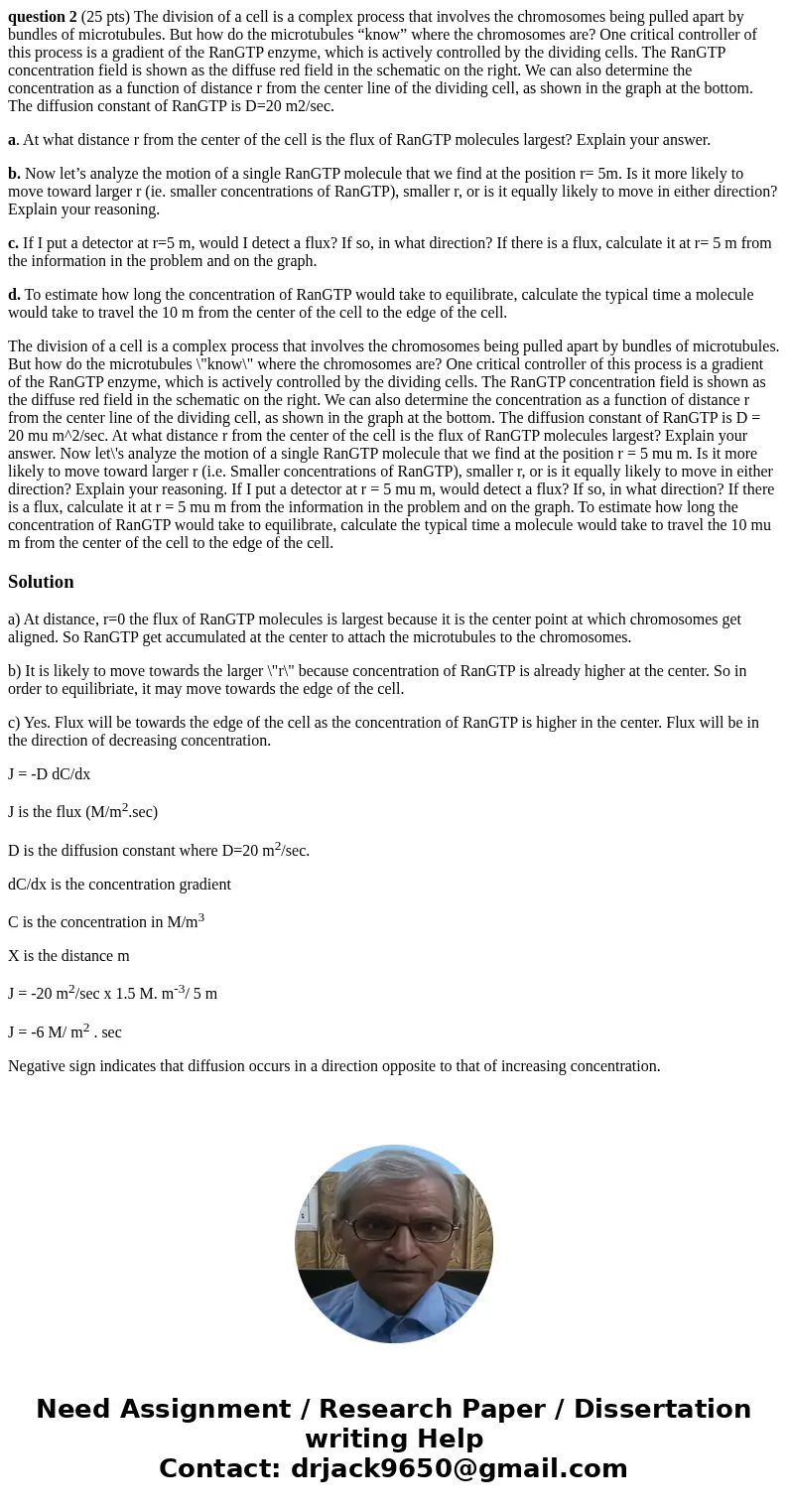question 2 25 pts The division of a cell is a complex proces
question 2 (25 pts) The division of a cell is a complex process that involves the chromosomes being pulled apart by bundles of microtubules. But how do the microtubules “know” where the chromosomes are? One critical controller of this process is a gradient of the RanGTP enzyme, which is actively controlled by the dividing cells. The RanGTP concentration field is shown as the diffuse red field in the schematic on the right. We can also determine the concentration as a function of distance r from the center line of the dividing cell, as shown in the graph at the bottom. The diffusion constant of RanGTP is D=20 m2/sec.
a. At what distance r from the center of the cell is the flux of RanGTP molecules largest? Explain your answer.
b. Now let’s analyze the motion of a single RanGTP molecule that we find at the position r= 5m. Is it more likely to move toward larger r (ie. smaller concentrations of RanGTP), smaller r, or is it equally likely to move in either direction? Explain your reasoning.
c. If I put a detector at r=5 m, would I detect a flux? If so, in what direction? If there is a flux, calculate it at r= 5 m from the information in the problem and on the graph.
d. To estimate how long the concentration of RanGTP would take to equilibrate, calculate the typical time a molecule would take to travel the 10 m from the center of the cell to the edge of the cell.
The division of a cell is a complex process that involves the chromosomes being pulled apart by bundles of microtubules. But how do the microtubules \"know\" where the chromosomes are? One critical controller of this process is a gradient of the RanGTP enzyme, which is actively controlled by the dividing cells. The RanGTP concentration field is shown as the diffuse red field in the schematic on the right. We can also determine the concentration as a function of distance r from the center line of the dividing cell, as shown in the graph at the bottom. The diffusion constant of RanGTP is D = 20 mu m^2/sec. At what distance r from the center of the cell is the flux of RanGTP molecules largest? Explain your answer. Now let\'s analyze the motion of a single RanGTP molecule that we find at the position r = 5 mu m. Is it more likely to move toward larger r (i.e. Smaller concentrations of RanGTP), smaller r, or is it equally likely to move in either direction? Explain your reasoning. If I put a detector at r = 5 mu m, would detect a flux? If so, in what direction? If there is a flux, calculate it at r = 5 mu m from the information in the problem and on the graph. To estimate how long the concentration of RanGTP would take to equilibrate, calculate the typical time a molecule would take to travel the 10 mu m from the center of the cell to the edge of the cell.Solution
a) At distance, r=0 the flux of RanGTP molecules is largest because it is the center point at which chromosomes get aligned. So RanGTP get accumulated at the center to attach the microtubules to the chromosomes.
b) It is likely to move towards the larger \"r\" because concentration of RanGTP is already higher at the center. So in order to equilibriate, it may move towards the edge of the cell.
c) Yes. Flux will be towards the edge of the cell as the concentration of RanGTP is higher in the center. Flux will be in the direction of decreasing concentration.
J = -D dC/dx
J is the flux (M/m2.sec)
D is the diffusion constant where D=20 m2/sec.
dC/dx is the concentration gradient
C is the concentration in M/m3
X is the distance m
J = -20 m2/sec x 1.5 M. m-3/ 5 m
J = -6 M/ m2 . sec
Negative sign indicates that diffusion occurs in a direction opposite to that of increasing concentration.

 Homework Sourse
Homework Sourse